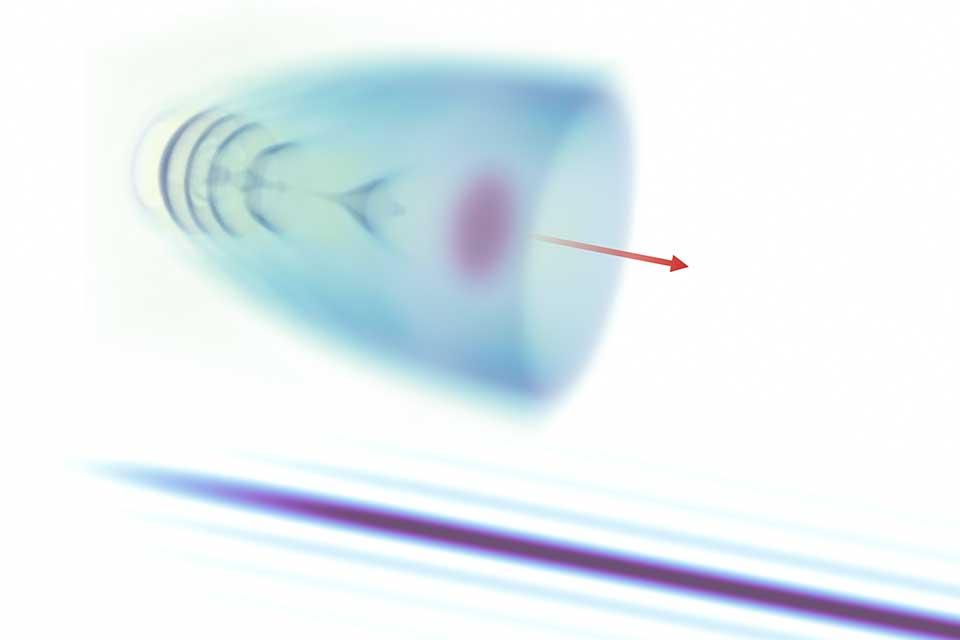Researchers at the Department of Physics at the University of Oxford have found solutions to two major challenges with laser-plasma accelerators. The findings put these compact sources of energetic particles and radiation a step closer to application in science, medicine and industry.
First conceptualised in 1979, laser-driven plasma accelerators use ultra-high intensity laser pulses propagating through a plasma (an ionized gas) to generate strong plasma waves that support accelerating electric fields up to a thousand times stronger than a traditional, radio-frequency accelerator. Electrons trapped in the plasma wave can be accelerated to highly relativistic energies in only a few centimetres.
Laser-plasma accelerators are well suited to driving very compact sources of energetic particles and radiation, with many potential applications in science, medicine, and industry. However, several challenges must be overcome before many of these can be realised. In a recent paper published in Physical Review Letters, the Oxford Laser Plasma Accelerators Group (LPAG) led by Professor Simon Hooker present a solution to two of these challenges: firstly ensuring that the driving laser pulse remains focused over the length of the accelerator; and secondly, injecting electrons into the plasma wave a precise point in time and space.
Achieving high intensity
In order to achieve the high intensity required to drive the plasma wave (around 1018 W cm-2), the drive laser must be focused to a small area, typically about 30 microns in diameter. Beyond the focus the laser will diffract in just a few millimetres, reducing the laser intensity, stopping plasma wave generation. To beat this limit, the Oxford group have developed a new type of ‘plasma channel’ ie an optical fibre made out of plasma, in which the transverse density profile of the plasma is shaped so as to continually focus the light as it propagates along the axis of the channel. The hydrodynamic optical-field-ionised (HOFI) plasma channel developed by the Oxford group is generated by focusing an auxiliary laser pulse with a conical lens (known as an ‘axicon’) to form a cylinder of hot plasma. The subsequent radial explosion of this cylinder leaves a cylindrical cavity of low density plasma surrounded by a ring of higher density. This is just the shape required to form a ‘plasma optical fibre’, and if the channel-forming laser pulse is timed to arrive a few billionths of a second before the drive laser pulse, the drive laser can be guided along this channel with low losses.
Controlling the injection of electrons
The second challenge addressed by the new work was that of controlling the injection of electrons into the plasma wave. In most experiments to date, electrons are trapped in the plasma wave via highly nonlinear and poorly controlled processes. As a consequence, the quality of the accelerated bunches is low, and the properties of the bunches change significantly shot-to-shot, both of which prevent laser-plasma accelerators being used in the most demanding applications. In the recent experiments, the Oxford group were able to generate and exploit a sharp decrease in density at the start of the plasma channel. As the main laser propagated through that sharp decrease, the wavelength of the plasma wave abruptly increased, and a highly localised bunch of electrons became trapped on the oscillating plasma wave. Those electrons could subsequently ride the plasma wave inside the plasma channel, gaining energy.
The Oxford group showed that, under optimised conditions, high quality electron bunches were accelerated up to energies of 1.2 GeV in an 11-cm-long plasma channel. This equates to an accelerating electric field 100x greater than conventional accelerators. Additionally, the group’s simulations showed that increasing the length of the channel to 41cm (which is technically feasible) would increase the bunch energy to 3.65 GeV while maintaining high beam quality. Electron bunches with these properties could power an X-ray free-electron laser generating laser-like radiation with wavelengths below 10nm.
Alex Picksley, the lead graduate student on the experiment said, ‘One of the most exciting things about this scheme is that it demonstrates the flexibility of these types of channels and I look forward to seeing how this can be exploited further in the future.’
Professor Hooker added, ‘These exciting results are the culmination of a huge effort over many years by all members of the Oxford LPAG group, first to develop and understand these novel plasma channels, and then to devise novel ways in which their properties could be exploited to enable them to produce high-quality, high-energy electron beams.’
All-optical GeV electron bunch generation in a laser-plasma accelerator via truncated-channel injection, A Picksley et al, Physical Review Letters, 12 December 2023

